Safaa M. A. Yadak
Qassim University, KSA, Al-Mulida, Saudi Arabia
Correspondence to: Safaa M. A. Yadak, Qassim University, KSA, Al-Mulida, Saudi Arabia.
| Email: |  |
Copyright © 2017 Scientific & Academic Publishing. All Rights Reserved.
This work is licensed under the Creative Commons Attribution International License (CC BY).
http://creativecommons.org/licenses/by/4.0/

Abstract
Analyzing measurement invariance is important across groups or across time. The study utilized Entwistle (1981) test for the purpose of exploring the measurement invariance between three majors at Qassim University and identifying the different learning styles used by students enrolled in these different majors. The test validity and reliability was verified. A convenient sampling technique is used torecruit the participants, two hundred-forty female students from Qassim University enrolled in scientific, literary and economy and management majors at the academic year 2016/2017 completed the test. The participants had an average level in the three learning styles (deep, surface and strategic), means scores range between (3.27-3.66) degrees, the deep learning was ranked first and its means score was 3.66 degrees, followed by the strategic learning M=3.59 degrees and the surface learning was ranked the last M=3.27 degrees. Statistical significant differences were found between the literary majors and both of the management and economy and the scientific majors in favor of the management and economy majors, statistical significant differences were also found in deep learning in the scientific majors compared with surface learning. Statistical significant differences at α=0,05 between the literary majors and both of management and economy and the scientific majors were found, the differences were in favor of management and economy and the scientific majors in deep and surface learning. Statistical significant differences were found at α=0,05 between the literary majors with both management and economy and scientific majors in favor of management and economy and scientific majors. Significant differences were found at α=0,05 between the management and economy and scientific majors in favor of management and economy in the strategic learning.
Keywords:
Learning styles, Deep learning, Surface learning, Strategic learning, Measurement invariance
Cite this paper: Safaa M. A. Yadak, Measurement Invariance of Learning Styles Index between Three Different Majors at Qassim University, International Journal of Applied Psychology, Vol. 7 No. 2, 2017, pp. 29-35. doi: 10.5923/j.ijap.20170702.01.
1. Introduction
Research of learning styles is considered an important means to recognize the relationship between the learning styles, majors and recognize the preferred learning style within a certain major compared to another, or if the learning style is considered a unique individual state that differs from one individual to the other within the same major. Because the accuracy of the comparison is based on the accuracy of the index used in the; the needs to verify good psychometric features of the test is important.Students major is affected by many variables, the most important are those related to the learner himself such as his preferred learning style. The students learning outcomes are attributed to his preferred learning style; hence, various preferences show different individual learning outcomes and help educators in finding the best ways to invest learners' energies and helps students to solve problems, which in its turn reflects on the learners' motivation toward learning. Recognizing the preferred learning style helps in explaining the change that occurs in the academic achievement, that is learning styles are considered determinants of learning outcomes among students [1].[2] In their study said that the learning styles represent a part of the learner's formation. Learning styles summarize the learner's needs, emotions, beliefs and attitudes about the way in which learning occurs. Learning styles are considered the powers that enable the learners' understanding of new and complex information. Followers of this trend believe that individuals are active, they try what helps them to learn, and they search for information to solve problems and rearrange and organize the learnt material in order to understand the new knowledge. They also rely on test, experiment and decision making to achieve their goals instead of depending on the surrounding events which imparts a significant impact on this method in terms of learning. The focus of cognitive psychology on the role of knowledge increased, because what had been learnt previously determines, to a large extent, what the individual likes to learn and recall in future [3]. The learning style is defined as the method preferred by the learner to learn, the definition is broader than the concept of cognitive style which is always confused with the learning style, and the cognitive style refers to the learners’ method in processing the information [4]. The learning style is also defined as a combination of cognitive, emotional and psychological factors that work as indicators of the learner's interaction and responding to the environment [5].[6] Confirmed that the word of “learn” means different things, depending on the values and beliefs of the learner, learning style and major that may affect the learner nature and way of learning.The assumption of a correlation between the learning style and the major is not new, [7] provided evidence for the family and school socialization importance to prepare the learner to choose his major and this is directly related to developing the learning style.[8] Asserted that measure invariance is a prerequisite of the comparison between the learners, whether they are enrolled in different majors or their age groups are different.The latent trait theory assumes that each individual has a level of the variable to be measured, this level affects the responses on the measure items, consequently, the correct response represents the ability or the existence of the variable intended to be measured. This possibility increases with the ability or the existence of the variable [9].[10] Said that most of the reports of the learning styles confirmed the importance of the academic content and context in affecting the students learning style. The preferred style may be affected by recognizing the learner's environment and the features of the teaching process that affects learning include teaching methods, the teacher's enthusiasm degree and the level of the provided information. The characteristics of the major include its nature, the content of the learning material, the teaching methods, the study skills available and most important the workload and evaluation procedures.[10] Classified the learning styles into the following categories: 1. The deep learning style. Individuals having this learning style are distinguished by their ability and willingness to search for the meaning and to use similarity in describing ideas in an integrated manner, in addition to connecting new ideas with old experiences; they also tend to use evidence and argumentation in their learning.2. The surface learning style. Individuals having this learning style are distinguished by the ability to recall facts on certain topics that are related to the questions on the topic, they depend on clear instructions, determined curricula, memorizing and the logical style in reaching the facts.3. The strategic learning style. Individuals having this learning style are distinguished by their ability to organize study times, their positive tendencies toward studying, their motivation to achieve success, and they always try to choose the appropriate method that determines the optimal learning style.Therefore, few scientists define the learning styles as the cognitive, emotional and fixed psychological properties that are used as predictors of the learner's cognitive quality, their interaction and response toward the learning environment [10].
2. Literature Review
As far as the author knows, the studies that have explored the measurement invariance of the learning styles between different majors in general are very few, and in specific between students in different majors at Qassim University are not found, but some studies tackled the learning styles with other variables such as;[11] compared the dominant learning styles between native speaker's and nonnative speakers of English. Korean, Malay, Arab, Spanish, Japanese, Thai, Indonesian, Chinese and English speaking students participated in the study. Arab and Chinese speakers preferred the visual style compared with the auditory. Nonnative speakers of English showed a negative preference of the group learning.[12] studied the learning styles among the students of Gar Younis University in light of gender and major variables. Statistical differences were not significant in the learning styles attributed to the major, but were significant among the students in the literary majors in the facts retaining style.[13] studied the differences between the deep, surface and strategic learning styles. Statistical significant differences were found in the deep learning style between the literary and scientific majors in favor of scientific majors, and in the surface learning style between literary and scientific majors in favor of the literary majors. The differences of the strategic learning style between the literary and scientific majors were not significant.[14] studied the learning strategies among students of open learning majors (kindergarten and class teacher programs) at Damascus University and there relation to age, gender, major and high school certificate type. He utilized the learning strategies test developed by Deborah Stipek/ California University and Heidi gralinski/ Harvard University. The test included 11 items allocated to the two dimensions of the effective strategies (5 items) and the surface strategies (6 items). Statistical significant differences between the learning strategies and the majors were found in favor of kindergarten program.[15] Studied the learning styles and the level of knowledge need and their relationship among middle school students. The author implemented the test of [16], it included 44 items. A simple random sample of 222 students participated in the study. Students did not have a preferred learning style, but they needed knowledge.
2.1. Study Problem
The topic of measurement invariance of tests implemented on students in different majors received little interest from authors in the Arab environment; fewer studies are found comparing learning styles of different majors. The scarcity of such studies in the Arab environment and the importance of the topic prompted the author to attempt exploring measurement invariance between three majors at Qassim University and identifying the different learning styles used by students enrolled in different majors by answering the following questions:1. Are the psychometric properties of the learning styles test different based on major's difference?2. What are the dominant learning styles among the students of the faculties of Arts and sciences at Qassim University?3. Are there statistical significant differences at α=0,05 between responses means in the learning styles test attributable to the major?
2.2. Study Importance
The study examined the measurement invariance between three majors at Qassim University and identified the different learning styles used by students enrolled in these different majors. This study may be considered a part of the theoretical and practical literature that highlights the measurement invariance between the learning style and the major at Qassim University; it provides a statistical method to insure measurement invariance between different majors and may be the core for further studies in future. Lack of Arabic and local studies on the topic urged the author to undertake the current study. This study contributes to the development of learning outcomes among students; it enables scholars to make comparisons between different groups of students enrolled in different majors, in order to recognize their preferred learning styles and the direct them for the optimal learning style appropriate to get the best learning outcomes in their major.
2.3. Study Goals
Ÿ Identify the required steps to insure measurement invariance of the learning styles questionnaire.Ÿ Recognize the differences in the preferred learning style of each major.
2.4. Procedural Definitions
Measurement invariance. It verifies that the degree that the leaner obtained on the test or a specific item is based on what the learners owns of the property measured. But the obtained degree is not dependent on the major of the learner.Learning Style. The learning style is the method used in managing information in various educational situations regardless of the requirements of the learning process. Procedurally it is the degree obtained by the learner on the learning style test that includes the deep, surface and strategic learning styles.
2.5. Study Limitations
Generalizing the results of the study may be hindered by the validity and reliability of the test; The sample was recruited from Qassim University/ faculty of sciences and arts at Ar-Rass. Therefore, the results are valid to generalize only on the population of this study and similar populations.
3. Methodology
3.1. Population
The study population included all the students of Qassim University.
3.2. Sample
The sample was recruited using a simple random technique, the participants were 240 students allocated evenly on the literary, scientific and economy and management majors.Table 1. Repetitions and percentages of the sample based on the major
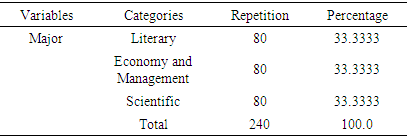 |
| |
|
3.3. Instrument
The study employed the index of the learning styles developed by [10]. The original index included five subscales (deep learning, surface learning, strategic learning, lack of direction and academic self-confidence). The author of the current study explored measurement invariance between three majors at Qassim University and identified the different learning styles used by students enrolled in these different majors, so the items measuring deep, surface and strategic learning were selected, each subscale included 10 items. The tests version was arabized to suit the Arab population, competent professors majoring in educational psychology and teaching methods reviewed the initial version of the test in terms of the dimension representation, suitability to measure the learning style, and items structure, based on their comments few items were modified. The participants selected the answer from a 5-point Likert scale by marking the answer that best suits their level of certainty in front of the item. The test was implemented on a pilot sample of (100) students selected in random.
3.3.1. Learning Styles Validity and Reliability
Factorial Validity. The subscales scores were analyzed by principal component and by Varimax rotation with Kaiser Normalization. The analyses revealed three factors that explained 53.063% of the variance in the student's responses. Table 2 illustrated the factors matrix and saturation following rotation and deleted the saturation values less than 0.3%.It is observed in table 2 that the factorial analyses of the learning style measure exhibited three saturated factors as follows:Table 2. Factors Matrix and Saturations
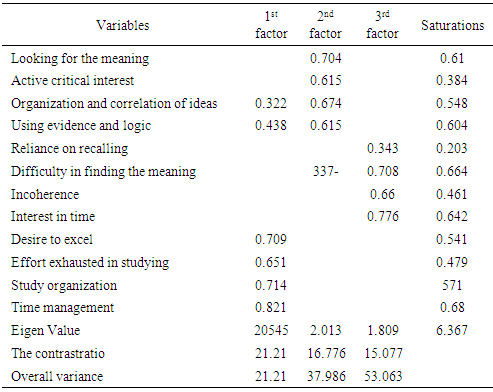 |
| |
|
The first factor was saturated with six dimensions, the saturation values scores range between 0.322 degrees for organization and correlation of ideas dimension and 0.821 degrees for the time management dimension. The table exhibited that all the dimensions suggested to measure the strategic learning style were saturated on this factor, the saturations scores were the highest, and therefore, this factor may be defined as the “strategic learning style”.The second factor was saturated with five dimensions, these dimensions were suggested to measure the deep learning style, and their saturation values were positive and the scores range between 0.615–0.704 degrees. The dimension of “difficulty in finding the meaning” which is one of the surface learning style dimensions was saturated negatively, therefore, this factor may be defined as the “deep learning style”.The third factor was saturated with four dimensions, their saturation values scores range between 0.343–0.776 degrees. The four dimensions that were suggested to measure the surface learning style, they are “Reliance on recalling”, “difficulty in finding the meaning”, “incoherence” and “interest in time”, therefore, this factor may be defined as the “surface learning style”.The test factorial validity is proved; the analysis presented the three dimensions of: the deep, the surface and the strategic learning styles.
3.3.2. Test Stability
The test reliability was established, the internal consistency coefficient was calculated using Cronbach Alpha equation, and the scores of the subscales were: (0.72) for the deep style, (0.71) for the surface style and (0.85) for the strategic style. The overall score was (0.74), all the coefficients were high and reliable, and table (3) presents these values.Table 3. Internal consistency of the learning styles test
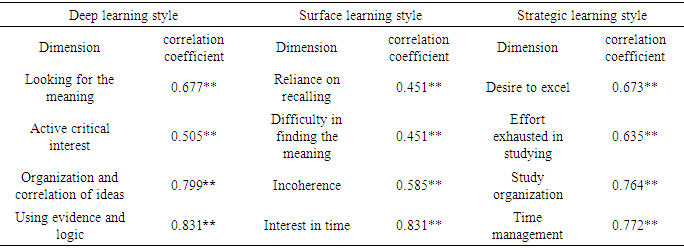 |
| |
|
From table 3 it is inferred that the correlation coefficients between the dimensions of the learning styles subscales and the overall degree of the style is functional at 0.01, referring to the test internal consistency.
3.3.3. Learning Styles Correcting Procedure
The total number of the items was (30) distributed evenly on the learning styles (deep, surface and strategic), to measure participants’ preferred style level, they were instructed to answer each item according to their level of certainty on a 5-point Likert type scale ranging from Never, Rarely, Sometimes, Often and Always. Accordingly, the overall degree score of each item range was between zero (the lowest degree obtained) and 150 degree (the highest degree obtained). By converting the scores into (1-5) degrees the following categories were obtained: (1-2.33) low level, (2.34-3.67) averaged level and (2.68-5) high level.
3.4. Procedures
The author obtained a consent form to implement the test at Qassim University, students were recruited in the study using a simple random technique, the participants were 240 students allocated evenly on the literary, scientific and economy and management majors. The test was presented to the students via email, they marked the answer that best suits their level of certainty, and then the data obtained was analyzed.
4. Results and Discussion
The study explored the measurement invariance between three majors at Qassim University and identified the different learning styles used by students enrolled in these different majors by attempting to answer the questions of “Are the psychometric properties of the learning styles test different based on majors difference?”, “What are the dominant learning styles among the students of the faculties of Arts and sciences at Qassim University?” and “Are there statistical significant differences at α=0,05 between responses means in the learning styles test attributable to the major?”To answer the first question of “Are the psychometric properties of the learning styles test different based on majors difference?” construct validity, test-retest reliability and internal consistency were verified.
4.1. Construct Validity
The correlation coefficients between the overall score and each item based on the major were computed, the scores are presented in table 4.Table 4. Correlation Coefficients between the Items and the Overall Degree Based on the Major
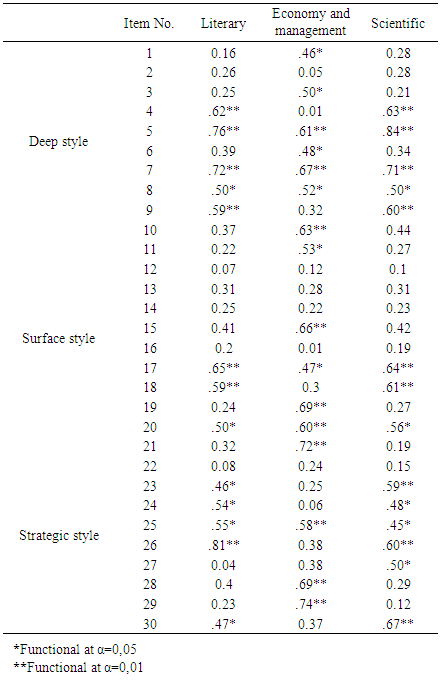 |
| |
|
All the correlation coefficient were acceptable and statistically significant, therefore, none of the items was excluded.
4.2. Test-Retest Reliability
The test was retested after an interval of two weeks to verify its reliability; the results were computed by Pearson spearman between the estimates of the respondents in the two times. Table 5 illustrated the resultsTable 5. Test-retest of the Learning Styles Based on the Major
 |
| |
|
4.3. Internal Consistency
To insure the internal consistency based on Cronbach’s Alpha it was computed from the responses of the sample, the results obtained were considered appropriate for implementation, table 6 illustrates these results.Table 6. Cronbach Internal Consistency Coefficient for the Learning Styles Based on the Major
 |
| |
|
The aim was to recognize the items that identify the different property between equal learners even if their majors were different, in order to verify the measurement invariance by the psychometric properties of the learning styles based on different majors.To answer the second question “What are the dominant learning styles among the students of the faculties of Arts and sciences at Qassim University?” means and standard deviations of the dominant learning styles among the students of Qassim University were computed. Table 7 illustrates the results.Table 7. Means and Standard Deviations of the Dominant Learning Styles in Means Descendant Order
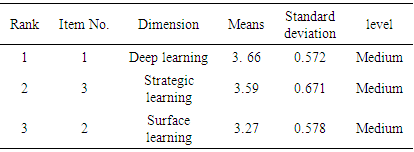 |
| |
|
It is observed in table 7 that the means scores range was between 3.27-3.66, the deep learning means scores were ranked first (M.= 3.66), the strategic learning was ranked second (M.=3.59) and the surface learning was ranked third (M.=3.27). the intermediate levels scores may be explained by the fact that most learners do not reach the degree of depth in learning for several reasons such as: success in studying does not mean that the learner is learning deeply, it means that he has recognized the method of success only, teachers of deep learning are rear, the dominant style is the deep learning, the curricula, programs and formal directions in education does not encourage deep learning, the typical methods in preparing tests contributed in surface learning by focus on memorizing information, accepting ideas without understanding them, concentrating on information isolated from previous experiences which in turn produce an averaged strategic learning student who cannot organize studying time or chose the optimal learning method. To answer the third question and “Are there statistical significant differences at α=0,05 between responses means in the learning styles test attributable to the major?”, means and standard deviations of the students responses on the learning styles based on the major were computed as observed in table 8.Table 8. Means and Standard Deviations of the Dominant Learning Styles Based on the Major
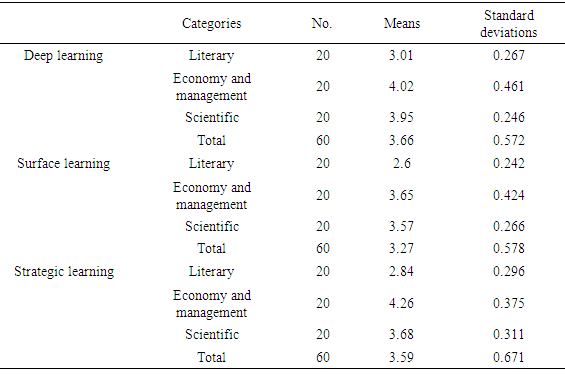 |
| |
|
From table 8 an apparent variance is noticed in the means and standard deviations of the students responses on the learning styles attributed to different majors, to examine the difference function between means ANOVA analysis is conducted, as illustrated in table 9.Table 9. ANOVA analysis of the Students Responses on the Learning Styles Test
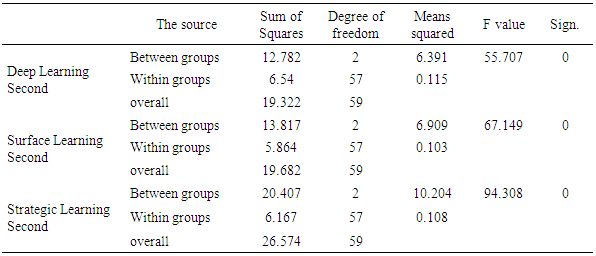 |
| |
|
As seen in table 9, statistical significant differences were found at α=0,05 attributed to the major in all the learning styles, to examine the statistical significance functions between the means a Scheffe test is implemented as shown in table 10.Table 10. Scheffe test of the Major Effect on the Students Responses on the Learning Styles
 |
| |
|
As observed in table 10 statistical differences at α=0,05 are found between the literary majors and both of scientific and economy and management majors in favor of economy and management and the scientific majors in the surface and deep learning. This result may be attributed to deep learning association with practice and this is a characteristic of some scientific majors and economy and management because the learner practices what he learns in the real life and correlates learning with the career. The need to learn is a basic principal in developing learning, the deep learning leads the learner to the core of the topic. The deep learning corresponds with surface learning which is important in any topic. In the deep learning students depend on a sequence of clear steps to reach facts, this behavior leads to practice later. The results of the current study agree with [13], he found significant differences in the deep learning between students majoring in literary and sciences, results were in favor of the scientific majors, and found significant differences in the surface learning between the students in the two majors, the results were in favor of the literary majors. This study found statistical significant differences at α=0,05 between the literary majors and both of scientific and economy and management majors in favor of economy and management and the scientific majors in the strategic learning. This result may be attributed to the fact that many of the real problems that face learners is their inability to organize what they perceive or inability to integrate possibilities which may be a direct cause of the learning problems, especially in the literary majors that depend on memorizing and recalling only. The economy and management majors depend on dealing with numbers and students in them are organized and always try to choose the study method that suits their major.
References
| [1] | Mashi, Mohammad, & Yosef, Suleiman. (2006). Predictive value of the preferred learning style based on Reid's model of the academic achievement among the foundation year students at the University of Jazan having different levels of social intelligence. Jazan University Humanities Journal, 3, 1, 91-129. |
| [2] | Villaverde, J., Godoy, D., & Amandi, A. (2006). Learning styles recognition in e -learning environments with feed -forward neural net-works. Journal of Computer Assisted Learning, 22, 197 - 206. |
| [3] | Qatami, Yousef & Qatami, Nayfeh. (2000). Psychology of classroom learning. Amman: Dar AlShoroup. |
| [4] | Riding, R., & Cheema, I. (January 01, 1991). Cognitive Styles--An Overview and Integration. Educational Psychology: an International Journal of Experimental Educational Psychology, 11, 193-215. |
| [5] | Duff, A. (June 01, 2001). A note on the psychometric properties of the Learning Styles Questionnaire (LSQ). Accounting Education, 10, 2, 185-197. |
| [6] | Jaju, A., Kwak, H., & Zinkhan, G. M. (July 01, 2002). Learning Styles of Undergraduate Business Students: A Cross-Cultural Comparison between the US, India, and Korea. Marketing Education Review, 12, 2, 49-60. |
| [7] | Kolb, D.A. & Fry, R. (1975) "Towards an applied theory of experiential learning" ch.3 pp.33-57 in Cooper, C.L. (Ed.) Theories of Group Processes (Wiley: London). |
| [8] | Greguras, G. J. (April 01, 2005). Managerial Experience and the Measurement Equivalence of Performance Ratings. Journal of Business and Psychology, 19, 3, 383-397. |
| [9] | Allam, Salah Addein. (2001). Diagnostic tests: the criterion-referenced test in psychological, educational and training domains, 2. Cairo: darelfikrelarabi. |
| [10] | Entwistle, N. (1981). Styles of learning and teaching, New York: John Wiley & Sons Ltd. |
| [11] | Reid, J. M. (March 01, 1987). The Learning Style Preferences of ESL Students. Tesol Quarterly, 21, 1, 87-111. |
| [12] | Yaser, Amer & Kazem, Ali Mahdi. (1998). Learning styles among the students at Gar Younis University. Association of Arab Universities Journal, 33. |
| [13] | Alsobati, Ibrahim. (2002). The differences in learning styles among university students in light of the major and level of academic achievement, faculty of education, King Faisal University, KSA. |
| [14] | Zheily, Ghassan. (2012). Learning strategies and their relationship with social and personal variables. A field study applied on the students of open learning. Damascus University Journal for Educational Sciences. 28, 1, 357-391. |
| [15] | Al-Kaabi, Kazem. (2015). Learning styles and their relationship to the need for Cognition among middle school students. Alustath Journal. 2, 214, 201-236. |
| [16] | Felder, R. M., & Spurlin, J. (2005). Applications, Reliability and Validity of the Index of Learning Styles. International Journal of Engineering Education, 21, 1, 103-112. |



 Abstract
Abstract Reference
Reference Full-Text PDF
Full-Text PDF Full-text HTML
Full-text HTML








